It’s time for “Helping Tomer Identify Small Mammals based on Terrible Pictures!”
So I didn’t do my homework on small mammals before goign to the CAR… So I kind of learned some of the squirrels and galagos as I went along. Well, the red-legged sun squirrels and the tiny but noisy green bush squirrels were readily identified (most of the time), and I got a good look at but no photos of Thomas’s rope squirrel twice. But the rest I’m kind of having trouble identifying:
- Could this be not a red-legged sun squirrel? It looked a bit smaller, and its leg, frankly, more red-legged than the rest:
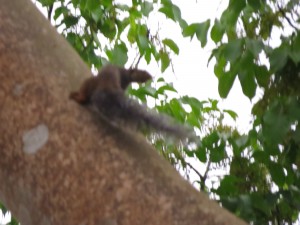
- This squirrel looked more like pictures I saw of African Giant squirrel than of the red-legged sun squirrel. Any thoughts?
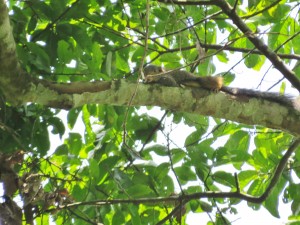
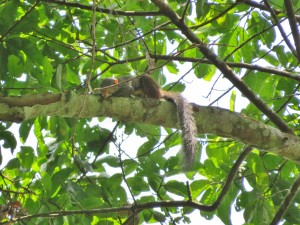
- The next one I think is for sure a rope squirrel… but which one?
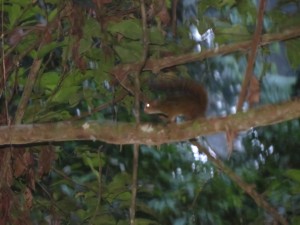
- And then there’s this terrible picture:
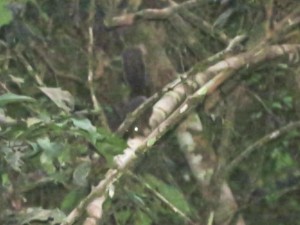
- Finally, there’s what I believe is an actual red-legged sun squirrel. Confirmation?
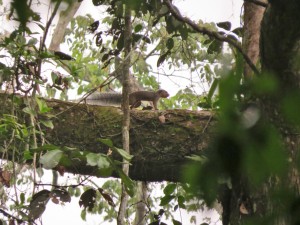
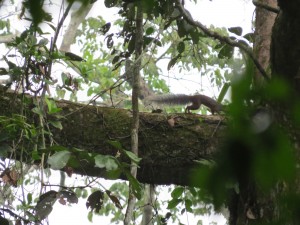
Next is a galago:
- So if the pictures weren’t bad enough, check out this threesome of horrible, out of focus pictures:
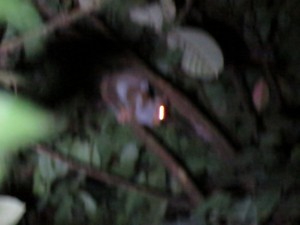
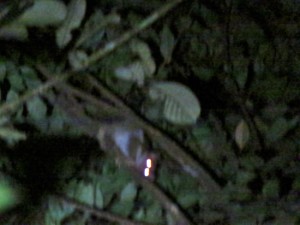
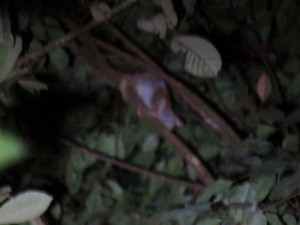
So even though they’re out of focus and not sharp, you can clearly make out the contrasting whitish under-parts of the body and brownish limbs, wiht pink-ish/Orangish hands and feet. The head is definitely more grey than the belly, and it has a face the same color as the hands and legs. It looks like the tail is grey as is the back of the animal and is uniform. It was much smaller than the elegant needle-clawed galago (I have better pictures of that one, wiht the white tip of the tail, and its hands and feet aren’t this color), and larger and didn’t look anything alike the tiny Demidoff’s galago. From the mammal book they had, the only one that made sense to me was the squirrel galago, but what do you guys think? - Now onto some mice. The fist one was seen along the River trail of Sangha Lodge. A wood mouse?
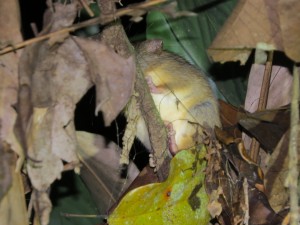
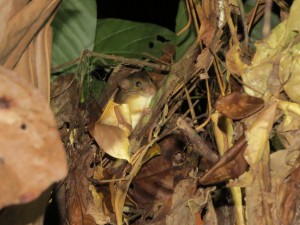
- And another individual down the trail, of probably the same species:
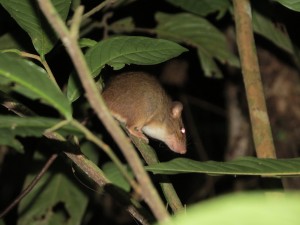
- Then a mouse that was caught outside of Cabin 1 in the lodge. We were actually going to release it further in the forest, but it fled the bag prematurely. Not before we measured its tail which was like 10-12 cm, I think:
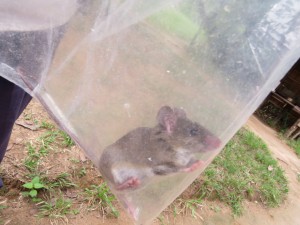
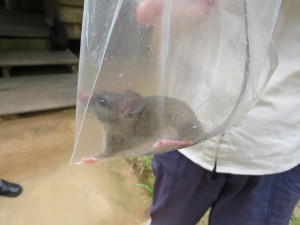
- And finally, a couple of bats. I’m totally helpless on bats… the first one was really large, almost like a flying fox. It reminds me of what Coke Smith called a “signing fruit bat”, but that’s just a very superficial observation so, please feel free to correct me:
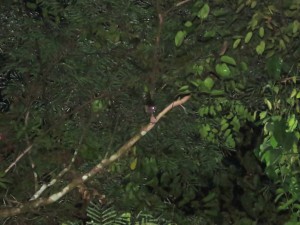
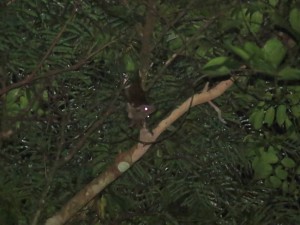
- And last (and maybe least), the bats behind the waterall at Bai Hoku. I think Coke named them Noak’s Roundleaf bats? To me, one looks different than all the rest. Again, sorry for the bad picture (I promise to have better pictures of larger animals in my upcoming report):
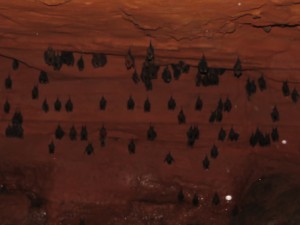
S
o that’s it! Thanks in advance to anyone who attempts to ID some of my least good pictures of the trip. I promise you the pangolin pictures are better 😉
Cheers!
Tomer
9 Comments
-
-
-
Vladimir Dinets
There is a chance that 1 is fire-footed rope sq. (if back stripes got somehow blended in the photo), but I don’t think it’s compact enough.
2 could be giant, yes.
I can’t be sure but I’d say 3 is Thomas’s. Did you note what the alarm call sounded like?
4 looks like green bush sq. to me.
5 should be red-legged; rope sq’s don’t have tail bands.
Gabon squirrel galago is supposed to have grey head, orangish limbs and slightly yellowish underparts. Have you considered Thomas’s galago? Did you hear any calls?
7 & 8 don’t seem to be brown/chestnut enough for wood mice, and I am not convinced they are the same species (the ears look different, although it could be damaged in 7). Did you see 7’s tail? Also, what was the size?
What was h&b length in 9? Tail length and color fit Mastomys natalensis.
10 is female hammerhead, perhaps? I’ve never seen that species except in flight.
11 The bats at Bai Hoku are supposed to be Noak’s, but I didn’t visit that colony. Orange color results from ammonia bleaching in some individuals and doesn’t affect the ID.Now let’s hope Rod will stop by and tell you what they all really are 🙂
-
Vladimir Dinets
The galago photos are not particularly informative, so if Rod thinks it’s squirrel galago, it’s probably squirrel galago. Note that Kingdon’s book exaggerates its affinity to lower strata and ground feeding.
If #8 is a Hylomyscus, it should be H. alleni, because H. walterverheyni are more orange there (see photos in my trip report).
#7 seems to have yellow lower flanks, in which case it’s not a Hylomyscus. If it was on the River Trail, could be Malacomys longipes.
If #9 is a Praomys, I think the only species in the area with matching tail length is P. tullbergi, but since it looks like a juvenile, it could be the larger and more common P. jacksoni. P. miosnnei & P. patteri don’t seem to occur there, but you can double-check. -
Vladimir Dinets
I am not an expert on Praomys, but that’s what IUCN range maps say (or said the last time I checked, which was in January). Of course, they are not a perfect source of information – far from it. What I would recommend is to wait for the next volume of HMW, due this summer. I can tell you what it says as soon as I get it (I’m getting them for free because there are my photos in them, la-la-la-la-la).
Leave a Reply
You must be logged in to post a comment.


Venkat Sankar
I think the first is Red-legged Sun Squirrel, as I’m not sure what else it could possibly be. That species tends to be quite variable.
The second is almost certainly an African Giant Squirrel IMO.
The third looks like Lady Burton’s or Ribboned Rope Squirrel. The photo quality makes it tough for me to tell the difference, but my guess is Lady Burton’s.
The fourth is a Rope Squirrel of some sort; I have no idea which species. Could you tell me what the habitat was (i.e. near water or not, etc.)?
I think 5 is a Red-legged Sun Squirrel.
Thomas’s is another suggestion for #6; was it higher up in the canopy (then most likely Thomas’s), or close to the ground in dense thickets (in which case Allen’s would make more sense).
I’ll leave the small rodents and fruit bat to people more knowledgeable in those areas than me.
Finally, they’re probably all Noack’s Roundleaf Bat. Bat coat color in these caves can change depending on the amount of ammonia (which can bleach fur and make it orange in color).